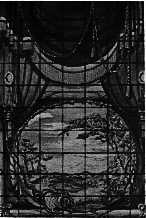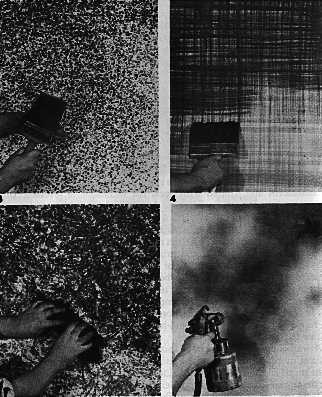back
to Set Designer part 2
SET DESIGNER Part 3
Scene Painting
There are two main difference between painting scenery and painting
for a gallery display: the scene painter adheres to the scene designer's
ideas and the scene painter must compensate for the distance between audience
members and the scenery.
The designer may paint his own sets or it may be a specialized job.
In either case, painter's elevations are prepared to give an exact
miniature of how a piece of scenery will look when painted. The set
designer will have already considered the coordination of color with the
costume and lighting designers before scenery can be painted. For
example, a red dress against a red scenic object will make an acress disappear
into the very red environment. Lighting can similarly enhance a painted
set or distort the colors.
Scale of painting for the stage must be generally large to compensate
for the distance between stage and audience and the strength of lighting
instruments which will both tend to make details disappear. However,
a small arena stage with close audience members will require more detailed
painting than a large proscenium house with an orchestra pit between the
stage and seating areas. To understand how painters use this distance,
consider an impressionist painting (Monet's water lilies, for example)
and how it's effect varies depending on how close you stand to the canvas.
Close up you may see only incoherent blotches of color, whereas at a distance
your eye creates the pattern of the landscape in some detail.
The scene painter translates a painter's elevation to a piece of scenery
by marking each into grids and copying the information from the small scale elevation to the corresponding
larger scale scenic object. The scene painter often uses a paintframe
to attach large pieces of scenery vertically and then be able to move it
up and down to reach various parts of the object while standing on the
floor.
and copying the information from the small scale elevation to the corresponding
larger scale scenic object. The scene painter often uses a paintframe
to attach large pieces of scenery vertically and then be able to move it
up and down to reach various parts of the object while standing on the
floor.
The scene painter is also concerned with adding depth and texture
to both flat pieces of scenery and pieces that are built with some texture
or three dimensionality. She uses line to create the illusion of
shadow from three dimensional objects or emphasize shadows on three dimensional
objects, like the molding of a wall or the underside of stones. She
has many possible ways to create texture. One possibility is to mix
something like sawdust into the paint itself. Another is to layer
the paint colors with such techniques as spattering, sponging, dry brushing,
wood grain, or marbling. Finally, she might use stencil or actual
wallpaper.
Painted scenery usually has a minimum of three colors applied
in some format; these colors may not be obvious from the distance
of an audience seat, but they are useful both to add texture to the set
pieces and to pick up changes of color in the stage lighting.
Properties Design
Set dressings, which includes objects like furniture or shrubs,
will usually be selected by the set designer. Stage and hand properties
may be selected by the set designer and costume properties by the costume
designer, or a separate properties designer may take on the "props." Set
or stage props are objects like pictures, candles, dishes or other
elements that stay on the set. Hand props are those objects
that actors actively use, like money, food, or cigarettes. Costume props
include makeup, fans, umbrellas, walking sticks, snuff boxes, and gloves.
Props for period plays, like Shakespeare's Hamlet, may
be quite involved, depending on the degrees of detail and of historical
accuracy desired by the director. Like the other designers, the properties
designer must support the director's overall concept for the production.
The props designer must also coordinate closely with the set and costume
designers. Since many props are actively used by actors, a props
designer must also be sensitive to actors' needs within a scene.
Canes, telephones, dishes, books, and suitcases must normally be functional
for actors. Even a contemporary play performed in a realistic style
will cause the props designer to make many choices about the best objects
for the stage. Every lamp, framed picture, and letter used on the
stage will communicate about the characters' personalities, tastes, and
interests. And each property must look appropriate with the scenery
and costumes.
Some properties require daily maintainance or replacement, like food
that is eaten, a mirror that is shattered, cigars that are smoked, or letters
that are torn up. In such a case the designer must acquire many copies
of the same objects.
End of Set Design Readings
BACK TO BLOOD'S COURSE MATERIAL
HOMEPAGE
 and copying the information from the small scale elevation to the corresponding
larger scale scenic object. The scene painter often uses a paintframe
to attach large pieces of scenery vertically and then be able to move it
up and down to reach various parts of the object while standing on the
floor.
and copying the information from the small scale elevation to the corresponding
larger scale scenic object. The scene painter often uses a paintframe
to attach large pieces of scenery vertically and then be able to move it
up and down to reach various parts of the object while standing on the
floor.